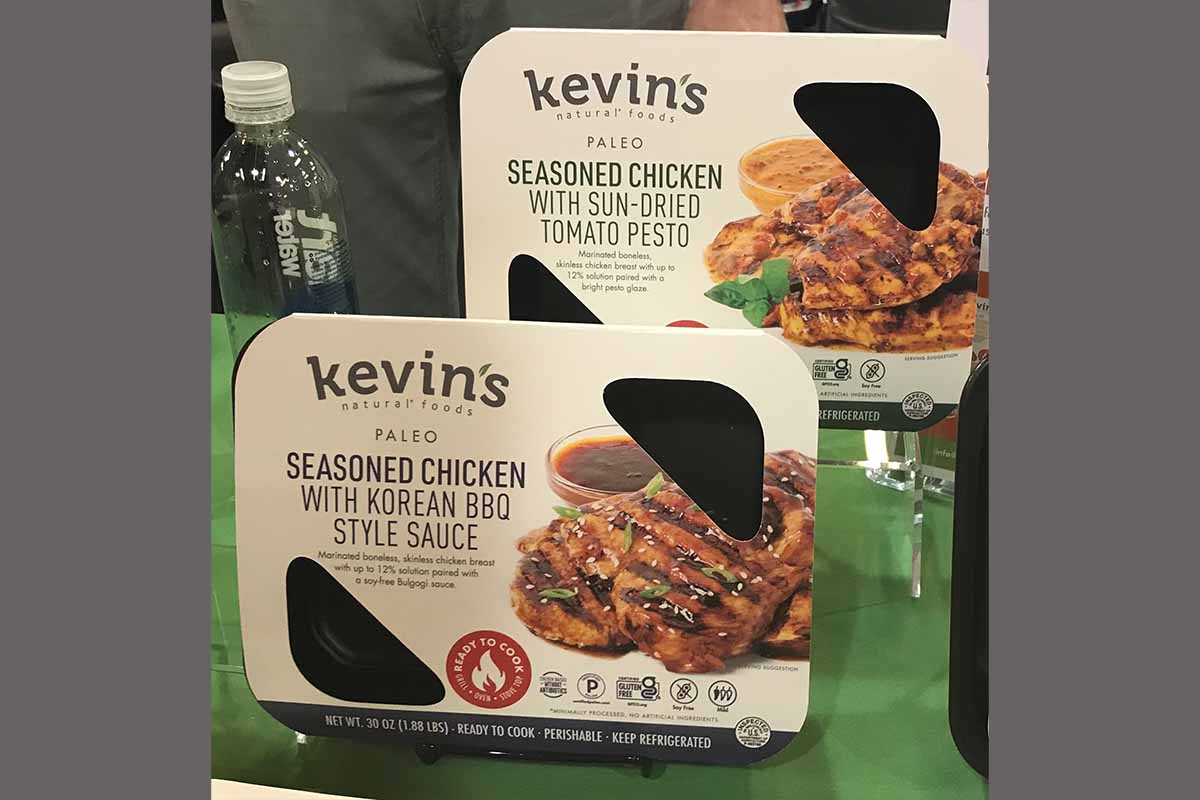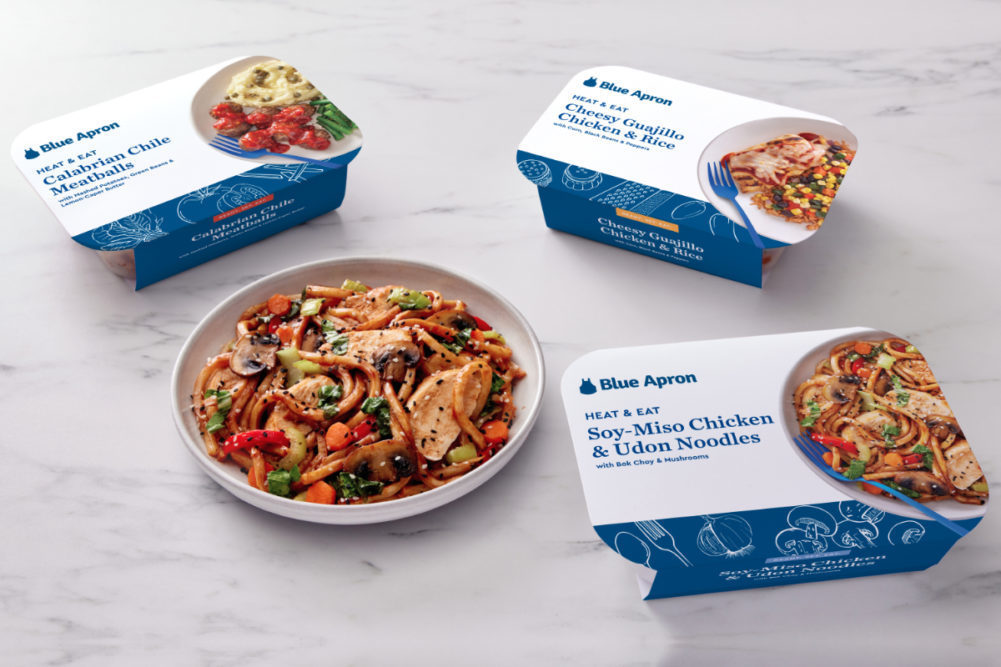With Mother Nature disrupting most of the country this winter with atypical weather patterns, Blue Apron, New York, set out to provide meal kit subscribers with global culinary escapes they can make and enjoy from the comfort of home. New recipes include Charred Gochujang Pork Chops with Sour Cherry Soy Sauce and Ginger-Honey Carrots, Garlic-Caper Chicken with Creamy Calabrian Zucchini and Orzo, Moroccan-Style Chicken and Couscous with Prunes and Yogurt, Pork Belly Bánh Mì with Mango Salad, and Vietnamese-Style Turkey Meatballs with Sweet Chili Mayo and Lemongrass Rice.
“Blue Apron is a firm believer in empowering home cooks to embrace their culinary curiosity and challenge their abilities in the kitchen,” said John Adler, vice president of physical product at Blue Apron. “Our inspiration comes from everywhere: meals we have eaten, books we have read, social media, our own family histories, new discoveries made at the grocery store and travels abroad.
“Anytime we identify an ingredient that we want to use for the meal kits, before we ever begin our onboarding process, we bring it into our test kitchen and evaluate its versatility,” he said. “If it will only work with one protein or in one dish format, then we likely won’t pursue adding it to the pantry. However, if we find that it can be used across dish formats and proteins, and we see where there are gaps to fill or places where we might need some redundancy, we will likely bring it on board.”
He explained that typically a recipe takes 12 weeks to go from concept to being delivered to a customer’s door. The test kitchen recipe development process may take a day for some meals, while others can take weeks.
“We want to make sure that every time we test a recipe, we can deliver on the different ways we are making the experience better for our customers,” Adler said.
No short cuts
Authenticity is key when setting out to provide consumers with an international culinary experience. Substituting cheap alternatives for the real deal does not invite retrial.
“We take pride in the ingredients we put into our box each week,” Adler said. “When we select them, we want to make sure they are the best representation of the particular ingredient that is available at scale and meets all of our sourcing requirements. When it comes to the authenticity of dishes, we want to be very respectful of the fact that everything we are creating are facsimiles or dishes inspired by other cuisines and cultures. We tend to call this out in our recipe titles and introductory copy.”
Blue Apron’s meals are meant to help people discover ingredients and learn new techniques to make their home-cooking experience more enjoyable and delicious. The company never claims that it is the true source for the most authentic recipes from across the globe.
“Doing so would be disrespectful to the time-honored traditions and foodways of other cultures,” Adler said.
Retail brands participating in the value-added meat and poultry space are wise to be authentic, but humble at the same time when adding international flavors to packaged proteins. Partnering with culinary professionals from around the world adds legitimacy to the flavor profile.
This is a space that a growing number of brands have entered, as showcased at the 2023 Meat Conference in Dallas, March 5-8, 2023. US consumers are buying more fresh meat and poultry than before the pandemic, but shoppers’ purchasing decisions are driven by a laser-like focus on value in terms of price, convenience and other attributes, according to the Power of Meat report. The survey defined value-added meat as items that are pre-marinated, pre-cut or pre-seasoned, such as kabobs, meatloaf, meatballs or pre-marinated chicken wings.
“Value-added meat has been a growth driver for several years, based on the combination of a higher consumption frequency and an increase in household penetration,” said Anne-Marie Roerink, principal, 210 Analytics, San Antonio, Texas, who presented the 18th edition of the report at the conference. “Engagement jumped ahead in 2020 as people looked for a helping hand with much greater levels of at-home meal preparation versus pre-pandemic. Convenience remains important despite the inflationary pressure on income, with the ever-growing popularity of value-added meat driving above-average sales gains.”
 Kevin's Natural Foods is offering marinated chicken in international flavor profiles (Source: Donna Berry/Sosland Publishing Company)
Kevin's Natural Foods is offering marinated chicken in international flavor profiles (Source: Donna Berry/Sosland Publishing Company)
What's hot in flavor
Authentic international flavors add value to center-of-plate proteins in restaurants and at home. Understanding what’s trending outside the home should provide inspiration for retail food brands.
The National Restaurant Association’s annual What’s Hot Culinary Forecast for 2023 identified sweet-heat fusion flavors on chicken, variations of sriracha on all types of applications, and the flavors of Southeast Asia (e.g., Vietnam, Singapore, Philippines, etc.) as growing in popularity on menus this year.
“Consumers will always want foods that reflect the familiar flavors they know and love, but they continue to expand their palates with unique global fare,” said Hudson Riehle, senior vice president of research for the National Restaurant Association. “With so many eyes on screens, social media plays a huge role in spreading the word about the latest flavor sensations. Consumers crave foods that challenge their taste buds at a more sophisticated level than ever before, including new levels of hot, spicy, sweet and savory. Whether it’s an Argentine choripan sandwich, or Jianbing, a Chinese breakfast crepe, consumers are ready to add stamps to their culinary passports.”
After Southeast Asia, the survey showed Caribbean (e.g., Puerto Rican, Cuban, Dominican, etc.) and South American (e.g., Argentinian, Brazilian, Chilean, etc.) flavors trending. The flavors of many of these countries may be showcased through a popular meat staple: chorizo. There are many versions of this spicy Spanish sausage, with seasonings influenced by the country of origin. And while most chorizo is made with pork and pork fat, there are varieties with beef or blends of meat.
Argentinian chorizo tends to be milder, while Mexican varieties have some kick. If it’s Cuban chorizo, cilantro will be a dominant flavor. Chorizo may contain an endless variety of peppers and spices, also often along with the fermented flavors of red wine or vinegar. Smoked paprika is almost always added, as it contributes a characterizing vibrant red color. However, Mexicans do make a green chorizo, which gets its color from green chilies and cilantro.
Volpi Foods, St. Louis, Mo., is rolling out Uncured Pepperoni & Chorizo Crumbles. The fully cooked crumbles have a bold, savory and smoky flavor profile with heavy notes of sweet paprika, pepperoncino flakes and fennel seed.
JBS USA Holdings Inc., Greeley, Colo., is adding pork chorizo to its AdapTable Meals lineup, which also includes other internationally inspired fresh, ready-to-cook meats. Examples include carne asada flank steak seasoned with onion, garlic and lime and Asian five-spice dry-rubbed boneless pork belly featuring anise, cinnamon, clove, fennel and ginger.
Mashups of international flavors with familiar carriers are also gaining traction. Bachan’s, Sebastopol, Calif., is debuting Miso Japanese Barbecue Sauce. It features a blend of red and white miso to provide a balance of mellow umami savoriness with bold flavor. It works with chicken, pork and steak.
Blue Apron partners with purveyors of globally inspired condiments to introduce its customers to unfamiliar, yet memorable dishes. Examples include tomato achaar and Calabrian chili paste.
“Our tomato achaar, a sauce created by Chitra Agrawal of Brooklyn Delhi, is a completely unique flavor and product in our pantry,” Adler said. “While she created this in New York, it is based on the achaar she grew up with in India. We partnered with her to bring this — along with her mango chutney and coconut korma sauce — to transform our pantry of Indian ingredients, but we use them in both Indian and some non-Indian dishes that are likely more familiar to our customer base, such as pastas, burgers and quesadillas.”
Kevin’s Natural Foods, Stockton, Calif., is rolling out grill-ready marinated chicken in three international flavor profiles: Hawaiian BBQ, Korean BBQ and Sun-Dried Tomato Pesto. These are the first fresh meats from the paleo and keto processor. Until now, all proteins have been fully cooked and ready to eat from fridge to plate in about five minutes.
International flavors know no borders when it comes to flavoring meat and poultry. Adler said that he is happy to see that African flavors and ingredients are becoming more mainstream. He also expects to see more trial of Latin American cuisines as people explore the flavors of the Southern Hemisphere. 



